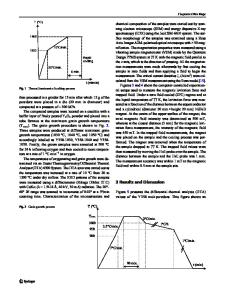Effect of increased growth velocity on the growth temperature of the Al-Al 2 Cu eutectic
- PDF / 125,336 Bytes
- 2 Pages / 612 x 792 pts (letter) Page_size
- 40 Downloads / 388 Views
Communications Effect of Increased Growth Velocity on the Growth Temperature of the Al-Al2Cu Eutectic
V, mm/s
10
60
74
150
330
600
TG , 8C
547.8
547.3
547.0 547.2
546.4
545.8 545.6
544.8
A. JUAREZ-HERNANDEZ and H. JONES Growth temperature TG and its dependence on growth velocity V are key parameters in determining which of various alternative solidification microstructures is selected by competitive growth.[1] Theoretical modeling of lamellar or fibrous regular eutectic growth predicts the relationship[2] TEU 2 TG 5 BEUV 1/2
[1]
where TEU is the equilibrium eutectic temperature and BEU is a material constant that depends on operative interfacial energies and entropies of fusion, solute diffusivity in the melt, and constitutional parameters. Equation [1] has been verified for a number of eutectics[3–9] including most recently, for the first time, the fibrous Al-Al3Ni eutectic[9] for which TEU 5 639.8 8C 6 0.4 8C and BEU 5 0.28 6 0.09 K s1/2 mm1/2. The present work on the lamellar Al-Al2Cu eutectic was carried out in parallel with that of Reference 9, in order to extend previous measurements[10,11] for this eutectic to comparably higher growth velocity. Al-33.1 wt pct Cu alloy was made by vacuum induction melting 99.99 pct Al and 99.99 pct Cu together in a recrystallized alumina crucible and casting under argon into a rectangular iron mold of cavity dimensions 18 by 50 by 155 mm. Samples of this ingot were remelted and vacuum injected into alumina tubes 150-mm long by 3-mm bore, so as to be suitable for further remelting and solidification at a preselected velocity in the range 10 to 600 mm/s in vertical Bridgman growth equipment. The operative temperature gradient was ,10-K/mm. Growth temperature TG was measured by water quenching the sample after the solidification front had passed one or two thermocouple hot junctions that had been prepositioned along the axis of the sample.[12] Postmortem longitudinal sectioning then enabled the position of the eutectic front to be determined in relation to the position of the thermocouple(s). Knowledge of the recorded thermocouple temperature(s) at the instant of the quenching and the temperature gradient then enabled TG to be determined. The results are given as TG vs V up to 600 mm/s in Table 1 and plotted as TG vs V1/2 in Figure 1 along with previous measurements for V up to 80 mm/s. The least-squares straight line fit in Figure 1 for the present data gives TEU 5 548.3 8C 6 0.1 8C at V → 0 and BEU 5 0.144 6 0.011 K s1/2 mm21/2 from its slope. Figure 1 shows that the new results are in excellent agreement with the earlier results of Borland and Elliott,[11] which employed a thermal valve furnace, V between 6 and 81 mm/s with an “almost zero” temperature gradient in liquid. The results of Tassa and Hunt[10] for their
A. JUAREZ-HERNANDEZ and H. JONES, Professor, are with the Department of Engineering Materials, University of Sheffield, Sheffield, S1 3JD United Kingdom. Manuscript submitted June 8, 1999. METALLURGICAL AND MATERIALS TRANSACTIONS A
Fig. 1—Growth
Data Loading...











